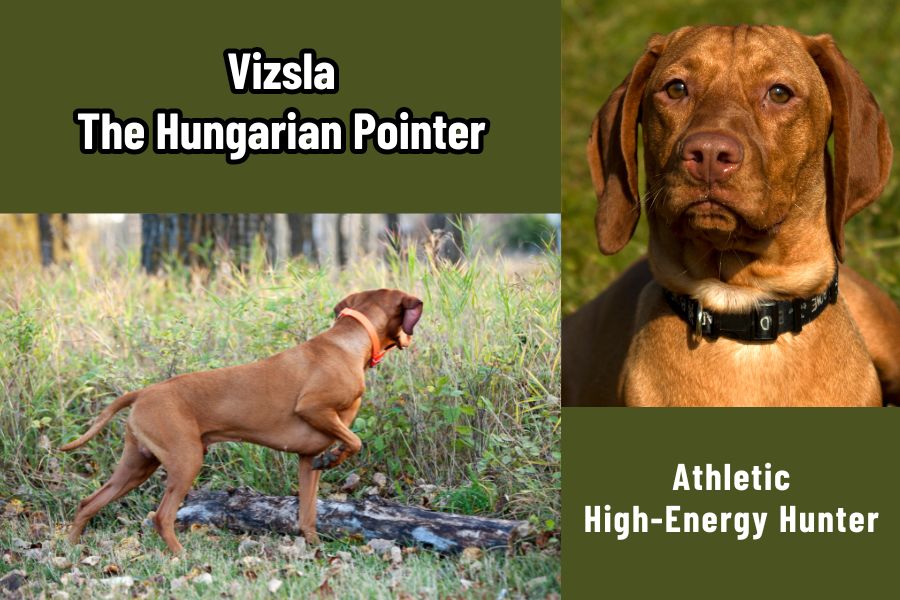Vizsla, discover the Hungarian Pointer’s rich history, distinct traits, expert care, and training tips, and why they make exceptional hunting and guard dogs.
Introduction
The Vizsla, often called the “Hungarian Pointer,” is a breed that is known for its athleticism and high-energy. With a history as vibrant as its striking rust-colored coat, the Hungarian Pointer is not just a dog; it’s a legacy of centuries-old hunting traditions. Imagine a dog that can seamlessly transition from a tireless hunting companion to a gentle family pet, embodying the perfect balance of grace and strength.
This guide is all about the Hungarian Pointer’s multifaceted nature. Whether you’re a hunting enthusiast, a family looking for a loyal and affectionate pet, or simply a dog lover eager to learn more about this exceptional breed, you’re in the right place. Let’s dive in and see what makes the Vizsla a truly extraordinary breed.
Vizsla Origin and History
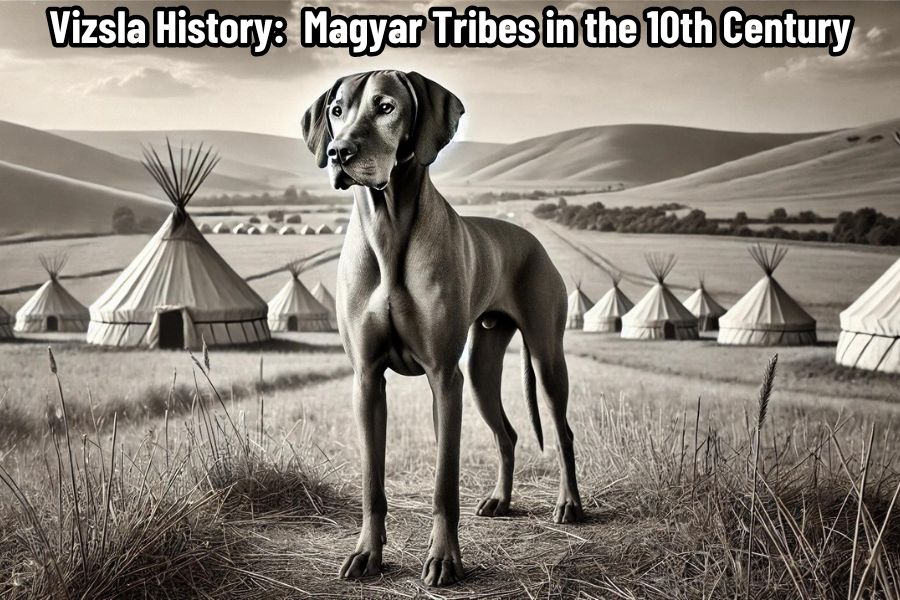
The Vizsla, with its roots deeply embedded in Hungarian soil, is a breed that stands as a testament to the rich heritage of Central Europe’s hunting traditions. Known for their agility, intelligence, and unwavering loyalty, the Hungarian Pointers have been cherished companions to hunters for centuries.
Ancestors
The Vizsla’s origin dates back to the 10th century in the Carpathian Basin, where Magyar or Hungarian tribes used them as versatile hunting dogs. These early Vizslas were a blend of various breeds, including the ancient Transylvanian Hound and the Turkish Yellow Dog, which contributed to their exceptional scenting and pointing abilities. Their primary role was to accompany noblemen on hunts, retrieving game from both land and water with remarkable efficiency.
Evolution
Throughout the Vizsla history, they have experienced their share of trials and triumphs. During the Turkish occupation of Hungary in the 16th and 17th centuries, Vizslas nearly vanished but were preserved by dedicated aristocrats who recognized their value. The breed faced another significant threat during World War II when Hungary’s war-torn landscape almost led to their extinction. However, through the efforts of passionate breeders, they not only survived but also thrived. Key milestones include the formation of the Hungarian Vizsla Club in 1920 and their introduction to the United States in the 1950s, marking the beginning of their international recognition.
Breed Status
Today, the Hungarian Pointer is a thriving breed both in the USA and worldwide. In the United States, there are thousands and their popularity is steadily increasing due to their versatility and affectionate nature. Globally, Vizslas are cherished for their roles as hunting dogs, family pets, and even therapy dogs. Their status as a beloved breed is cemented by their consistent ranking in the top 30 most popular breeds in the American Kennel Club (AKC).
Kennel Clubs
The Vizsla’s recognition by various kennel clubs is a testament to its esteemed status in the canine world. The American Kennel Club (AKC) recognized the Vizsla in 1960, while the United Kennel Club (UKC) followed suit in 1984. Across the Atlantic, The Kennel Club (TKC) in the UK acknowledged the breed in 1954, and the Canadian Kennel Club (CKC) did so in 1959. Other noteworthy organizations include the Fédération Cynologique Internationale (FCI), which recognized the Vizsla in 1936, further highlighting its global appeal and significance.
Vizsla In Action
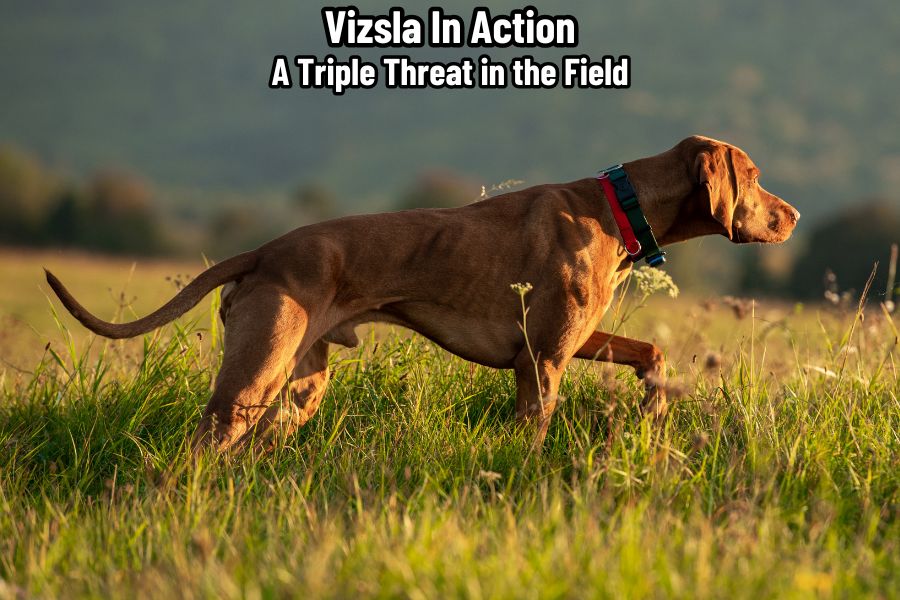
The Hungarian Pointer is a versatile breed, renowned for its prowess in the field and its adaptability to various roles beyond hunting. Whether tracking game, assisting in search and rescue, or excelling in dog sports, the Vizsla’s intelligence and agility make it an extraordinary companion in action.
Hunting Dog
The Vizsla hunting dog is revered as one of the best gun dogs. Its versatility makes it a triple threat in the field, proficient in locating, pointing, and retrieving game. Traditionally, Vizslas have been used to hunt a variety of game birds, including partridge, pheasant, and grouse. They can also be easily trained to hunt other small game such as rabbits, hare and squirrels, and larger game like wolf, bear, deer, and boar.
The hunting process for a Hungarian Pointer is a masterclass in precision and instinct. It begins with locating the game, where they use their keen eyesight and sense of smell to track down its quarry. Once located, they adopt a rigid stance, pointing directly at the game to alert the hunter. This pointing behavior is a critical part of the hunt, allowing the hunter to approach and prepare for a successful shot. Finally, and best of all, the Vizsla is a great retriever, with its gentle mouth, ensuring that the shot game is brought back undamaged.
Vizslas are also known for waterfowl hunting. They are great swimmers and make excellent retrievers for duck and geese hunters.
Other Roles
The Vizsla pointing dogs are not just extraordinary hunting dogs; they excel in various other roles, showcasing their intelligence and versatility. In the aftermath of the 9/11 attacks, they were instrumental in search and rescue efforts, utilizing their keen noses to locate survivors amidst the rubble. Their ability to work in high-pressure environments makes them invaluable as search and rescue dogs.
Vizslas have also proven their worth in detection roles. They are used by the Transportation Security Administration (TSA), law enforcement and the military as sniffer dogs, detecting explosives, drugs, and other hazardous materials with impressive accuracy. Their keen sense of smell and trainability make them ideal for this critical work.
Beyond their working roles, they are also cherished as therapy dogs. Their gentle and affectionate nature, combined with their high intelligence, allows them to provide comfort and support in therapeutic settings. Whether in hospitals, schools, or nursing homes, Vizslas excel at providing emotional support to those in need.
The versatile Vizsla also shines in the world of dog sports. Their agility, speed, and eagerness to please make them outstanding competitors in agility trials. They navigate complex courses with ease, demonstrating their athleticism and keen intelligence.
Vizsla Physical Traits
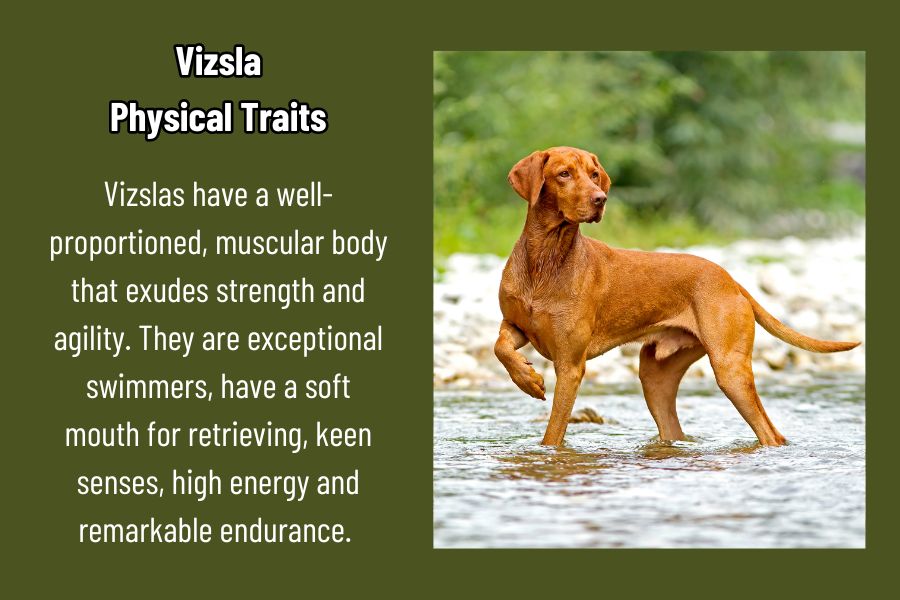
The Hungarian Pointer is a breed known for its athletic build and striking appearance. Their physical traits are perfectly suited for many roles. Lets take a closer look:
Strong Swimmers
Vizslas are exceptional swimmers, thanks to their powerful and well-muscled bodies. Their webbed feet and streamlined shape allow them to glide through the water with ease, making them excellent retrievers of waterfowl. Their affinity for water and strong swimming capabilities are a testament to their versatility and adaptability in various hunting environments.
Size (Length and Height)
The Vizsla size: they typically stand between 21 to 24 inches at the shoulder, with males being slightly larger than females. Their length from the chest to the base of the tail is proportional to their height, giving them a balanced and elegant appearance. This size is ideal for both agility and endurance, allowing them to navigate diverse terrains with ease.
Head and Muzzle (Soft Mouth)
The Vizsla’s head is lean and muscular, with a moderately wide skull and a distinct stop. Their muzzle is strong yet refined, tapering to a broad nose with open nostrils. One of the breed’s most notable features is its “soft mouth,” which means they can carry game without damaging it, a crucial trait for a hunting retriever dog.
Body Structure and Weight
Vizslas have a well-proportioned, muscular body that exudes strength and agility. They typically weigh between 45 to 65 pounds, with a deep chest that provides ample lung capacity for sustained physical activity. Their ribs are well-sprung, and their back is straight and strong, supporting their athletic build.
Coat Type and Colors
The Vizsla’s coat is short, dense, and close-lying, providing a sleek and glossy appearance. The most common color is a rich, golden rust, which is uniform throughout the coat. This color not only adds to their aesthetic appeal but also provides some camouflage in various hunting environments.
Keen Senses
Vizslas are renowned for their keen senses, particularly their sense of smell, which is highly developed and essential for tracking game. Their eyesight is sharp, allowing them to spot movement from a distance as well as shot game, plus their hearing is acute, making them responsive to commands even in noisy environments.
Tail Structure and Purpose
The Vizsla’s tail is typically docked to about two-thirds of its original length, though this practice varies by region. The tail is set just below the level of the back and is carried horizontally. It serves as part of the pointing position, a rudder when swimming and helps maintain balance during rapid movements in the field.
Energy and Endurance
Vizslas are known for their high energy levels and remarkable endurance in the field. This trait also makes them excellent companions for active families and individuals who enjoy outdoor activities. They do require significant daily exercise to keep them physically and mentally stimulated.
Life Expectancy
The Vizsla lifespan is between 12 to 15 years. With proper care, nutrition, and regular veterinary check-ups, they can enjoy a long and healthy life, providing companionship and joy to their families for many years.
Gestation Period and Litter Size
The gestation period for a Vizsla is approximately 63 days. They typically have litters of 6 to 8 puppies, though litter sizes can vary. Prenatal care and nutrition are crucial to ensure the health of both the mother and her puppies.
Vizsla Behavioral Traits
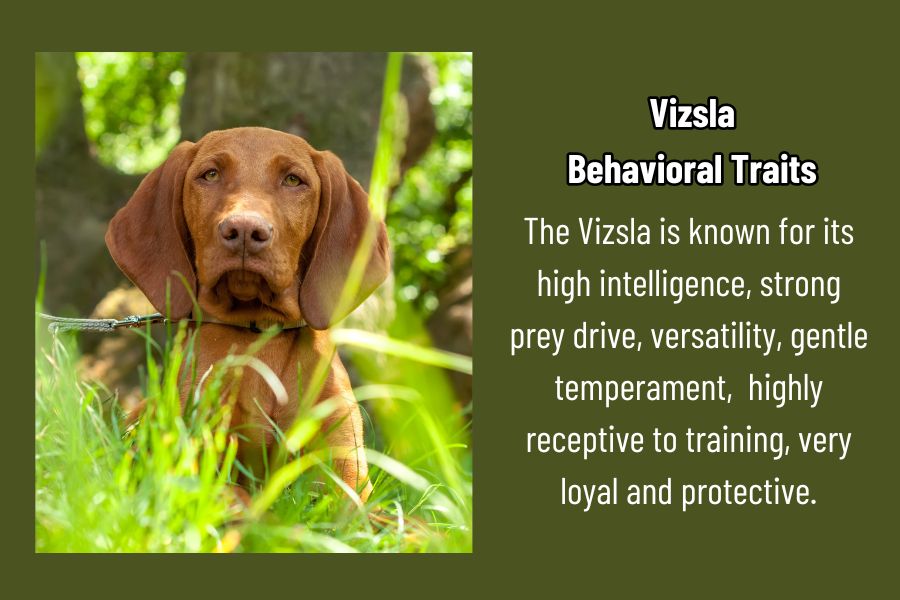
The Vizsla boasts a range of behavioral traits that make it a remarkable companion and working dog. Here are some impressive characteristics:
Prey Drive
Vizslas possess a strong prey drive, a trait deeply embedded in their genetic makeup as hunting dogs. This drive makes them highly motivated when it comes to tracking and capturing game, showcasing their natural hunting instincts. Their sharp senses and relentless pursuit make them exceptional in the field, whether they are hunting birds or larger game. This prey drive also means that they require proper training and management to ensure it is channeled appropriately, especially in domestic settings.
Intelligence
The Vizsla intelligence is evident in its ability to learn quickly and solve problems. They not only excel in hunting but other various canine sports and activities that require mental acuity. Their intelligence also makes them highly trainable, as they are quick to grasp new commands and routines. However, this also means they can become bored easily if not provided with enough mental stimulation.
Versatility
One of the most admirable traits of the Vizsla is its versatility. Originally bred for various hunting roles, they have adapted to other roles over the years, including search and rescue, therapy, and detection work. Their ability to excel in multiple domains makes them valuable as working dogs but also as beloved family pets who can participate in a range of activities.
Temperament
The Vizsla temperament is often described as the “velcro dog” because of their strong desire to be close to their owners. This breed thrives on human companionship and is known to be very sensitive to the emotions of their family members. Their affectionate nature also makes them excellent therapy dogs.
Trainability
Trainability is a hallmark of the Vizsla breed. Their eagerness to please, combined with their intelligence, makes them highly receptive to training. Positive reinforcement methods work best with this breed, as they respond well to praise and rewards. Consistent training from an early age helps harness their energy and instincts.
Loyalty and Protective
Loyalty is a defining characteristic of the Vizsla. They form strong bonds with their families and are known to be protective of their loved ones. While they are generally friendly and social, they can be wary of strangers, making them excellent watchdogs. Their protective nature is balanced by their gentle demeanor, ensuring they are vigilant without being overly aggressive.
Family Compatibility
Know as the Vizsla family dog, because they are highly compatible with families, including those with children. Their playful and energetic nature makes them great playmates, while their affectionate disposition ensures they are loving and gentle. They thrive in active households where they can participate in various activities and enjoy plenty of physical and mental stimulation. Their strong attachment to their family members makes them a loyal and devoted addition to any home.
How to Choose the Right Vizsla Puppy
Choosing the right Vizsla puppy is a crucial step in ensuring a happy and healthy relationship with your new canine companion. This process involves careful consideration of several factors to ensure that you select a puppy that fits well with your lifestyle and expectations.
Research Breeder and Pedigree
The first step in choosing a Vizsla puppy is to research reputable breeders. Look for breeders who prioritize health, temperament, and breed standards. A good breeder will provide you with detailed information about the puppy’s pedigree, including health clearances for common genetic issues such as hip dysplasia and eye conditions. Visiting the breeder’s facility, if possible, allows you to observe the environment in which the puppies are raised and to meet the puppy’s parents. This can give you a good indication of what to expect in terms of temperament and physical traits.
Evaluate Temperament of Puppies
When selecting a Vizsla puppy, it’s important to evaluate the temperament of each puppy. Spend time interacting with the puppies to observe their behavior. A well-adjusted puppy should be curious, playful, and sociable. Look for signs of a confident and friendly nature, as these traits are indicative of a puppy that will adapt well to various situations and training. Avoid puppies that show signs of excessive shyness or aggression, as these can be challenging traits to manage.
Evaluate Health and Energy Level of Puppies
Health is a critical consideration when choosing a Vizsla puppy. Ensure that the puppy appears healthy, with clear eyes, a clean coat, and a lively demeanor. Check for any signs of illness, such as coughing, sneezing, or digestive issues. It’s also important to consider the energy level of the puppy. The Hungarian Pointer is known for their high energy and need for regular exercise, so select a puppy that matches your activity level. Puppies that are too lethargic or hyperactive may indicate underlying health or behavioral issues.
Caring for Your Vizsla
Caring for your Vizsla involves a comprehensive approach. Here are some key tips:
Healthcare: Nutrition and Regular Checkups
Maintaining the health of your Hungarian Pointer starts with a balanced diet tailored to their specific needs. High-quality dog food rich in proteins, fats, and essential nutrients supports their active lifestyle and robust health. It’s important to consult with your veterinarian to determine the best diet for your Vizsla, considering factors such as age, weight, and activity level. Regular checkups are crucial for early detection of potential health issues including comprehensive health screenings, vaccinations, and dental care.
Regular Exercise and Grooming
Vizslas are high-energy dogs that require daily exercise to keep them physically and mentally stimulated. Activities such as running, hiking, and playing fetch are excellent ways to burn off their energy. Regular exercise not only keeps them fit but also prevents behavioral issues that can arise from boredom and pent-up energy. In addition to physical activity, they benefit from mental stimulation through training sessions and interactive toys.
Grooming a Vizsla is relatively straightforward due to their short coat. Regular brushing helps to keep their coat shiny and reduce shedding. Bathing should be done as needed, typically once a month, to keep their skin and coat clean. Don’t forget routine care such as trimming nails, cleaning ears, and brushing teeth to maintain overall hygiene and health.
Building A Lasting Bond
Building a strong bond with your Vizsla is essential for a fulfilling relationship. Spend quality time with your dog through activities like training, playtime, and simply being together. Vizslas thrive on human companionship and are known for their loyalty and affection. Positive reinforcement training methods work best with this sensitive breed, fostering trust and cooperation. Engage in activities that strengthen your bond, such as obedience training, agility courses, and cuddle time.
Vizsla Training Tips
Training your Vizsla is essential to ensure they become well-behaved and effective hunting companions. With their high intelligence and eagerness to please, they respond well to consistent, positive training methods. Focus training on their natural instincts locating, pointing and retrieving game:
5 Important Training Tips
- Establish Who’s In Charge: Begin with simple commands to ensure that your Hungarian Pointer understands you are always in charge. A useful tip is to use firm, but gentle, corrections and always reward positive behavior with treats and praise. Hand, body, eyes and face signals work best. This sets a foundation of respect and trust. This breed thrives on clear, consistent direction.
- Basic and Advanced Commands: Teaching your Vizsla basic and advanced commands is key to their development. Start with fundamental commands like “sit,” “stay,” “come,” and “heel.” As your dog masters these, move on to more complex commands such as “fetch” and “drop.” A helpful tip is consistency, use short, focused training sessions and practice regularly.
- Locating Game: Vizslas have natural scenting abilities that make them excellent at locating game. To hone this skill, introduce scent training early. A training tip is use scented training dummies and hide them in different locations and only reward your dog each time they successfully locate the scented dummy. This reinforces their natural abilities and improves their scenting proficiency.
- Pointing To Game: Pointing is an instinctive behavior in Vizslas, which makes them excellent hunting partners. Training tip, first, use the scented training dummy by holding the dummy in front of dog and work with dog to adopt the pointing stance. Second, hide the dummy, work with dog to locate by smell and then point to the dummy location. Regular practice of these two methods in different environments helps to solidify this skill.
- Retrieving Game: Retrieving is another natural skill for Vizslas. Start by playing fetch, using the training dummy. A key training tip, work with your dog to return the retrieved item directly to you without damaging or dropping. Practice “marked retrieves’ where the dog knows the location of the dummy and practice “blind retrieves” where the dog has to locate the dummy. Regular practice on these methods will sharpen their retrieving skills.
Stay Focused on the Training Plan – Don’t Experiment
Sticking to a consistent training plan is essential for your Hungarian Pointer’s success. Avoid experimenting with different methods or changing the training routine too frequently. Consistency helps your Vizsla understand expectations and builds a strong foundation of trust and learning.
Consider Hiring a Professional Trainer
If you encounter challenges or want to speed up the training process, consider hiring a professional trainer. An experienced trainer will provide personalized guidance and techniques tailored to your dog’s specific needs. It can be expensive, but a professional trainer can ensure your specific training goals are met and accelerate the learning process.
Conclusion
The Vizsla is an extraordinary breed, celebrated for its rich history, remarkable physical and behavioral traits, and exceptional versatility in various roles. From being an agile hunter to a loyal family companion, this breed embodies a perfect blend of intelligence, affection, and energy.
Whether you’re an avid hunter or looking for a loving and active pet, the Hungarian Pointer stands out as an exceptional choice. Check out our post about other pointing dog breeds.
FAQs: Vizsla
What breeds make up the Vizsla?
The Vizsla’s lineage is a blend of various hunting dogs from the Carpathian Basin, particularly the ancient Transylvanian Hound and the Turkish Yellow Dog. These breeds contributed to the Vizsla’s remarkable scenting and pointing abilities, making it a versatile and skilled hunting companion.
Why are Vizslas called “velcro” dogs?
The Vizsla is affectionately known as the “velcro dog” because of their strong attachment to their owners. This breed craves constant companionship and tends to stick close to their human family members, often following them from room to room. Their need for close contact and affection makes them loyal and loving pets.
How much does a Vizsla cost?
The cost of a Vizsla puppy can vary widely depending on the breeder, pedigree, and location. On average, you can expect to pay between $1,000 and $2,500 for a Vizsla puppy from a reputable breeder. Additional costs for health checks, vaccinations, and initial supplies should also be considered.
Are Vizslas protective dogs?
Yes, Vizslas are known for their protective nature. While they are generally friendly and sociable, they are also vigilant and can be wary of strangers. This combination makes them excellent watchdogs, as they will alert their owners to any unusual activity while remaining affectionate and gentle with their family.
Can Vizslas live in cold weather?
Vizslas can tolerate cold weather to some extent, but they are not particularly well-suited for extremely cold climates due to their short coat. In colder weather, it’s important to provide them with appropriate protection, such as dog coats or sweaters, and limit their exposure to harsh conditions. They thrive best in moderate climates where they can enjoy regular outdoor activities.
What are the potential health problems with the Vizsla breed?
Vizslas are generally healthy dogs, but like all breeds, they are prone to certain health conditions. Common health issues in Vizslas include hip dysplasia, epilepsy, and progressive retinal atrophy (PRA). Regular veterinary check-ups, a balanced diet, and proper exercise can help mitigate these risks and ensure a healthy, happy life for your Vizsla.
Resources: Vizsla
Online Resources
- AKC – American Kennel Club
- TKC – The Kennel Club
- UKC – United Kennel Club
- CKC – Canadian Kennel Club
- ISCA – Irish Setter Club of America
- VCA – Vizsla Club of America
Best Books
- “The Vizsla” by Bede Maxwell
- A comprehensive guide (a must-read) about this breed, covering history, breeding, training, and care.
- “Vizsla: A Comprehensive Guide to Owning and Caring for Your Dog” by Lavonia Harper
- This book provides detailed information about the breed’s characteristics, training, and care, making it a valuable resource for both new and experienced owners.
- “Training and Understanding Your Vizsla Dog and Puppies” by Vince Stead
- A practical guide focused on training techniques, behavior management, and understanding the unique needs of this breed.
- “The Complete Guide to Vizsla” by Tara Sanders
- An all-encompassing book that covers everything about this breed from the history to its care, training, and health..
- “Vizsla Bible: Your Perfect Guide Covers Puppies, Training, and Care by Mark Manfield
- This book offers an in-depth look at the breed, providing valuable insights into their training, behavior, and health care.

